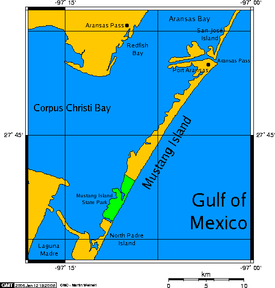Mustang Island

Map showing Mustang Island, in a long chain of barrier islands (see: Padre Island, to the south).
|
|
| Geography | |
|---|---|
| Location | Gulf of Mexico |
| Length | 24 mi (39 km) |
| Administration | |
| State | Texas |
| Counties | Nueces |
| Additional information | |
| Official website | Mustang Island State Park |
Mustang Island is a barrier island on the Gulf Coast of Texas in the United States. The island is 18 miles (29 km) long, stretching from Corpus Christi to Port Aransas. The island is oriented generally northeast-southwest, with the Gulf of Mexico on the east and south, and Corpus Christi Bay on the north and west. The island's southern end connects by roadway to Padre Island. At the northern end of the island is Port Aransas, beyond which is San José Island (also known as Saint Joseph Island). The Aransas Channel (also known as the "Aransas Pass"—for which the nearby town on the mainland is named), formed by the separation of Mustang and San José islands, is protected by jetties extending into the gulf from each island.
The town of Port Aransas is located at the northern end of the island. Mustang Island State Park encompasses the entire southern third of the island, including 3,954 acres (1,600 ha) and 5 miles (8 km) of beach. The city of Corpus Christi includes the northernmost portion of Padre Island and part of Mustang Island between Port Aransas and the state park.
The island is a popular Spring Break destination for its beaches.
In 1519, when Spanish explorer Alonso Álvarez de Pineda sailed through the pass to what he later named Corpus Christi Bay, the Karankawa Indians were likely the island's only residents. By the 18th century, as a result of grazing herds of horses introduced by Spanish settlers, the island was first called "Wild Horse", then "Mustang Island". Up to the 1840s the island and pass (now the ship channel) were used by buccaneers, Mexican smugglers, merchants and immigrants seeking their fortune or someone else's fortune.
...
Wikipedia
